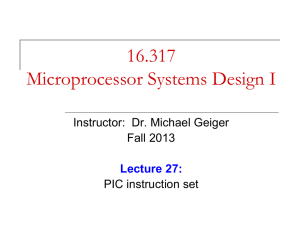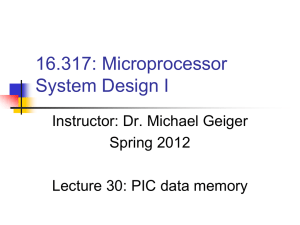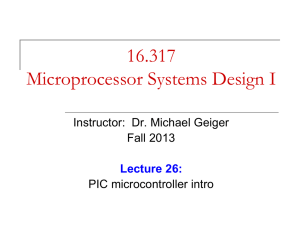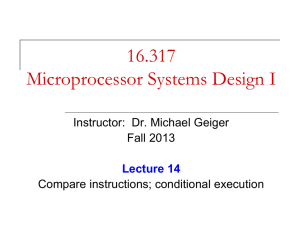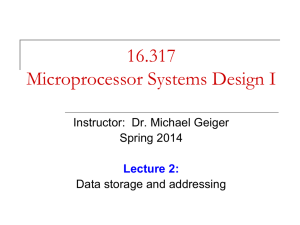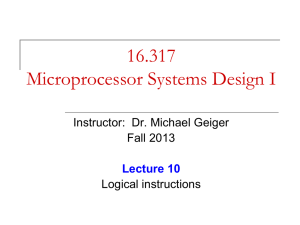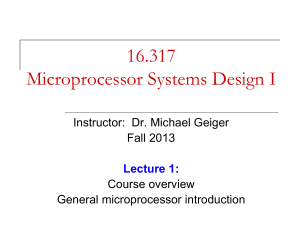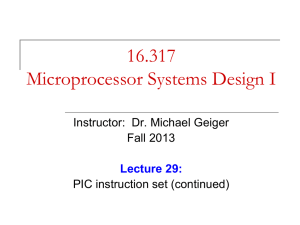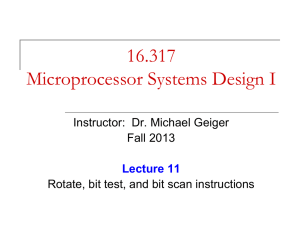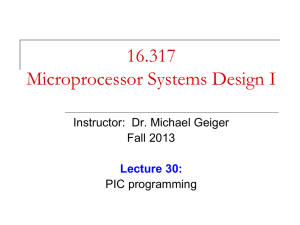F, 8/3 - Michael J. Geiger, Ph.D.
advertisement
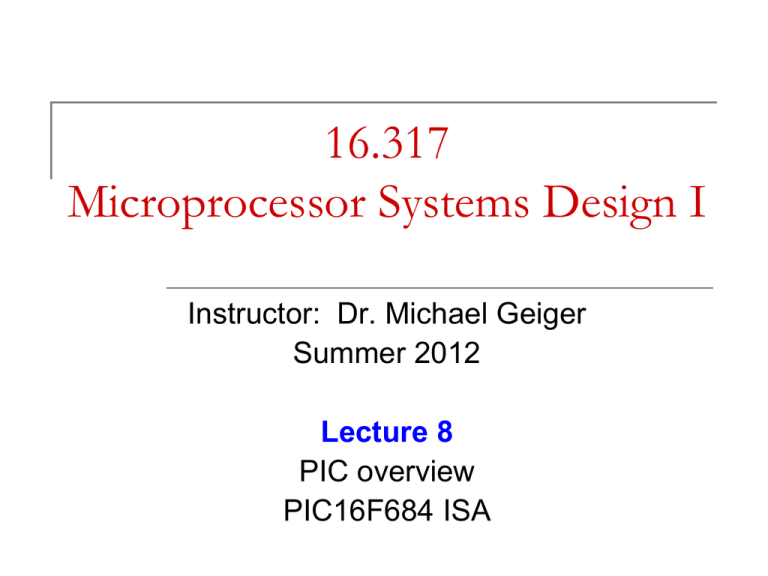
16.317 Microprocessor Systems Design I Instructor: Dr. Michael Geiger Summer 2012 Lecture 8 PIC overview PIC16F684 ISA Lecture outline Announcements/reminders Lab 4 due Wednesday, 8/8 HW 3 due Friday, 8/10 Turn in to my office by 1:45, or e-mail Exam 3: moved to Monday, 8/13 (not Wed 8/15) Lab 5 due Tuesday, 8/14 Will need to check out PICkit from lab—must contact me Same turn-in procedure as HW 3 Today’s lecture 4/13/2015 PIC intro Start PIC ISA Microprocessors I: Lecture 8 2 Overview of Microcontrollers Basically, a microcontroller is a device which integrates a number of the components of a microprocessor system onto a single microchip. Reference: http://mic.unn.ac.uk/miclearning/modules/micros/ch1/micro01notes.html#1.4 4/13/2015 Microprocessors I: Lecture 8 3 Microcontroller features Processor On-chip memory Usually general-purpose but can be app-specific Often RAM for data, EEPROM/Flash for code Integrated peripherals Common peripherals Special-purpose devices such as: 4/13/2015 Parallel I/O port(s) Clock generator(s) Timers/event counters Analog-to-digital converter (sensor inputs) Mixed signal components Serial port + other serial interfaces (SPI, USB) Ethernet Microprocessors I: Lecture 8 4 Microcontroller features Benefits Typically low-power/low-cost Easily programmable Target for embedded applications Simple ISAs (RISC processors) Use of development kits simplifies process Limitations 4/13/2015 Small storage space (registers, memory) Restricted instruction set May be required to multiplex pins Not typically used for high performance Microprocessors I: Lecture 8 5 PIC Microcontroller (PIC16F684) High performance, low cost, for embedded applications Low Power 8.5uA @ 32KHz, 2.0V Peripheral Features Only 35 different instructions Interrupt capability Direct, indirect, relative addressing mode 12 I/O pins with individual direction control 10-bit A/D converter 8/16-bit timer/counter Special Microcontroller Features Internal/external oscillator Power saving sleep mode High Endurance Flash/EEPROM cell 4/13/2015 Microprocessors I: Lecture 8 6 PIC16F684 Block Diagram 4/13/2015 Microprocessors I: Lecture 8 7 PIC16F684 4/13/2015 12 pins, 2048 instructions, 128 byte variable memory, ADC, comparator, Timers, ICD Microprocessors I: Lecture 8 8 Harvard vs Von Neumann Organization of program and data memory 4/13/2015 Microprocessors I: Lecture 8 9 Program Memory Space 13-bit program counter to address 8K locations Each location is 14-bit wide (instructions are 14 bits long) RESET vector is 0000h Interrupt Vector is 0004h 4/13/2015 When the CPU is reset, its PC is automatically cleared to zero. 0004h is automatically loaded into the program counter when an interrupt occurs Vector address of code to be executed for given interrupt Microprocessors I: Lecture 8 10 Data Memory Map Data memory consists of Special Function Registers (SFR) area General Purpose Registers (GPR) area SFRs control the operation of the device GPRs are area for data storage and scratch pad operations GPRs are at higher address than SFRs in a bank Different PIC microcontrollers may have different number of GPRs 4/13/2015 Microprocessors I: Lecture 8 11 Special Function Registers 4/13/2015 Microprocessors I: Lecture 8 12 Special Function Registers (1) W, the working register FSR (04h,84h,104h,184h), File Select Register Indirect data memory addressing pointer INDF (00h,80h,100h,180h) To move values from one register to another register, the value must pass through the W register. accessing INDF accesses the location pointed by IRP+FSR PC, the Program Counter, PCL (02h, 82h, 102h, 182h) and PCLATH (0Ah, 8Ah, 10Ah, 18Ah) 4/13/2015 Microprocessors I: Lecture 8 13 PCL and PCLATH 4/13/2015 PC: Program Counter, 13 bits PCL (02h): 8 bits, the lower 8 bits of PC PCLATH (0Ah): PC Latch, provides the upper 5 (or 2) bits of PC when PCL is written to 1st example: PC is loaded by writing to PCL 2nd example: PC is loaded during a CALL or GOTO instruciton Microprocessors I: Lecture 8 14 Special Function Registers (2) STATUS (03h, 83h, 103h, 183h) 4/13/2015 IRP: Register bank select bit (indirect addressing) RP1:RP0 – Register bank select bits (direct addressing) NOT_TO: Time Out bit, reset status bit NOT_PD: Power-Down bit, reset status bit Z: Zero bit ~ ZF in x86 DC: Digital Carry bit ~ AF in x86 C: Carry bit ~ CF in x86 (note: for subtraction, borrow is opposite) Microprocessors I: Lecture 8 15 Stack 8-level deep x 13-bit wide hardware stack The stack space is not part of either program or data space and the stackpointer is not readable or writable. The PC is “PUSHed” onto the stack when a CALL instruction is executed, or an interrupt causes a branch. The stack is “POPed” in the event of a RETURN, RETLW or a RETFIE instruction execution. However, NO PUSH or POP instructions ! PCLATH is not affected by a “PUSH” or “POP” operation. The stack operates as a circular buffer: 4/13/2015 after the stack has been PUSHed eight times, the ninth push overwrites the value that was stored from the first push. Microprocessors I: Lecture 8 16 Banking Data memory is partitioned into banks In this PIC family, each bank holds 128 bytes (max offset = 7Fh) Processors w/4 banks : 4*128 bytes = 512 bytes Processors w/2 banks : 2*128 bytes = 256 bytes Lower locations of each bank are reserved for SFRs. Above the SFRs are GPRs. Implemented as Static RAM Some “high use” SFRs from bank0 are mirrored in the other banks (e.g., INDF, PCL, STATUS, FSR, PCLATH, INTCON) RP0 and RP1 bits in the STATUS register selects the bank when using direct addressing mode. 4/13/2015 Microprocessors I: Lecture 8 17 Banking (cont.) 14-bit instructions use 7 bits to address a location Memory space is organized in 128Byte banks. PIC 16F684 has two banks - Bank 0 and Bank 1. Bank 1 controls operation of the PIC Example: TRISA determines which bits of Port A are inputs/outputs Bank 0 is used to manipulate the data 4/13/2015 Example: PORTA holds actual state of I/O port A Microprocessors I: Lecture 8 18 Direct/Indirect Addressing 4/13/2015 Microprocessors I: Lecture 8 19 Direct Addressing Lowest 7 bits of instruction identify a register file address The other two bits of register address come from RP0 and RP1 bits in the STATUS register Example: Bank switching (Note: case of 4 banks) CLRF :; BSF :; BCF :; MOVLW XORWF :; BCF :; BCF 4/13/2015 STATUS ; Clear STATUS register (Bank0) STATUS, RP0 ; Bank1 STATUS, RP0 ; Bank0 0x60 STATUS, F ; Set RP0 and RP1 in STATUS register, other ; bits unchanged (Bank3) STATUS, RP0 ; Bank2 STATUS, RP1 ; Bank0 Microprocessors I: Lecture 8 20 Direct addressing examples Assume you are using the PIC 16F684, which has two memory banks What address is being accessed if: 4/13/2015 STATUS = 60h, instruction = 031Fh? STATUS = 40h, instruction = 1F02h? STATUS = 13h, instruction = 0793h? STATUS = EEh, instruction = 03F1h? Microprocessors I: Lecture 8 21 Example solution Recall that, in direct addressing STATUS = 60h, instruction = 031Fh? Address is 8 bits Lowest 7 bits = lowest 7 bits of instruction 8th bit = RP0 bit of STATUS = STATUS bit 5 STATUS = 0110 00002 Instruction = 0000 0011 0001 11112 Address = 1001 11112 = 0x9F STATUS = 40h, instruction = 1F02h? 4/13/2015 STATUS = 0100 00002 Instruction = 0001 1111 0000 00102 Address = 0000 00102 = 0x02 Microprocessors I: Lecture 8 22 Example solution (cont.) Recall that, in direct addressing STATUS = 13h, instruction = 0793h? Address is 8 bits Lowest 7 bits = lowest 7 bits of instruction 8th bit = RP0 bit of STATUS = STATUS bit 5 STATUS = 0001 00112 Instruction = 0000 0111 1001 00112 Address = 0001 00112 = 0x13 STATUS = EEh, instruction = 03F1h? 4/13/2015 STATUS = 1110 11102 Instruction = 0000 0011 1111 00012 Address = 1111 00012 = 0xF1 Microprocessors I: Lecture 8 23 Indirect Addressing The INDF register is not a physical register. Addressing the INDF register will cause indirect addressing. Any instruction using the INDF register actually accesses the register pointed to by the File Select Register (FSR). The effective 9-bit address is obtained by concatenating the 8-bit FSR register and the IRP bit in STATUS register. Example NEXT: MOVLW MOVWF CLRF INCF BTFSS GOTO 0x20 FSR INDF FSR,F FSR,4 NEXT ;initialize pointer ;to RAM ;clear INDF register ;inc pointer ;all done? (to 0x2F) ;no clear next CONTINUE : 4/13/2015 ;yes continue Microprocessors I: Lecture 8 24 I/O Ports General I/O pins are the simplest of peripherals used to monitor and control other devices. For most ports, the I/O pin’s direction (input or output) is controlled by the data direction register TRISx (x=A,B,C,D,E): a ‘1’ in the TRIS bit corresponds to that pin being an input, while a ‘0’ corresponds to that pin being an output The PORTx register is the latch for the data to be output. Reading PORTx register read the status of the pins, whereas writing to it will write to the port latch. Example: Initializing PORTA (PORTA is an 8-bit port. Each pin is individually configurable as an input or output). bcf bcf clrf bsf movlw movwf 4/13/2015 STATUS, RP0 STATUS, RP1 PORTA STATUS, RP0 0xCF TRISA ; bank0 ; initializing PORTA by clearing output data latches ; select bank1 ; value used to initialize data direction ; WHAT BITS OF PORT A ARE INPUTS? ; WHAT BITS ARE OUTPUTS? Microprocessors I: Lecture 8 25 PIC16F684 Instructions 35 instructions Each instruction is 14 bits Byte-oriented OPCODE f, F(W) Source f: name of a SFR or a RAM variable Destination F(W): F if the destination is to be the same as the source register W if the destination is to be the working register Bit-oriented OPCODE f, b Bit address b (0≤b≤7) Literal and control OPCODE k Literal value k 4/13/2015 Microprocessors I: Lecture 8 26 RAM variables Memory variable: symbolic name to refer to space in memory (GPRs) Usable space on 16F684: 0x20–0x7F (Bank 0), 0xA0 – 0xBF (Bank 1) Once declared, use symbolic name, not address Example PIC syntax (cblock/endc): cblock 0x20 var1 var2 var3 endc 4/13/2015 ; cblock directive needs starting ; address ; var1 = byte at 0x20 ; var2 = byte at 0x21 ; var3 = byte at 0x22 ; End of variable block Microprocessors I: Lecture 8 27 4/13/2015 Microprocessors I: Lecture 8 28 Clear/Move clrw clrf f movlw k movwf f movf f, F(W) swapf f, F(W) Examples: clrf TEMP1 movlw 5 movwf TEMP1 movwf TEMP1, F movf TEMP1, W movf TEMP1, TEMP2 swapf TEMP1, F swapf TEMP1, W 4/13/2015 ; Clear W register STATUS bits: clrw, clrf, movf: Z ; Clear f register ; move literal value k to W movlw, movwf, swapf: none ; move W to f ; move f to F or W ; swap nibbles of f, putting result in F or W ;Clear variable TEMP1 ;load 5 into W ;move W into TEMP1 ;Incorrect Syntax ;move TEMP1 into W ; ;Incorrect Syntax ;Swap 4-bit nibbles of TEMP1 ;Move TEMP1 to W, swap nibbles, leave TEMP1 unchanged Microprocessors I: Lecture 8 29 Single Bit Manipulation bcf f,b STATUS bits: Operation: Clear bit b of register f, where b=0 to 7 none bsf f,b Operation: Set bit b of register f, where b=0 to 7 Examples: bcf PORTB, 0 bsf STATUS, C bcf STATUS, RP1 bsf STATUS, RP0 4/13/2015 ;Clear bit 0 off PORTB ;Set the Carry bit ; ;Select Bank 1 Microprocessors I: Lecture 8 30 Example Show the values of all changed registers after the following sequence cblock 0x30 x y endc clrw movwf movlw movwf swapf bcf bsf movf 4/13/2015 x 0xFE y y, F y, 3 x, 3 y, W Microprocessors I: Lecture 8 31 Example solution clrw movwf movlw movwf swapf bcf bsf movf 4/13/2015 W = 0x00 x x = W = 0x00 0xFE W = 0xFE y y = W = 0xFE y, F Swap nibbles of y y = 0xEF y, 3 Clear bit 3 of y = 1110 11112 y = 1110 01112 = 0xE7 x, 3 Set bit 3 of x x = 0000 10002 = 0x08 y, W W = y = 0xE7 Microprocessors I: Lecture 8 32 Increment/Decrement/ Complement incf f, F(W) decf f, F(W) comf f, F(W) ; increment f, putting result in F or W ;decrement f, putting result in F or W ;complement f, putting result in F or W STATUS bits: Examples: incf TEMP1, F incf TEMP1, W decf TEMP1, F comf TEMP1, F 4/13/2015 ;Increment TEMP1 ;W <- TEMP1+1; TEMP1 unchanged ;Decrement TEMP1 ;Change 0s and 1s to 1s and 0s Microprocessors I: Lecture 8 Z 33 Addition/Subtraction addlw addwf sublw k f, F(W) k subwf f, F(W) Examples: addlw 5 addwf TEMP1, F sublw 5 subwf TEMP1, F 4/13/2015 ;add literal value k into W ;add w and f, putting result in F or W ;subtract W from literal value k, putting ;result in W ;subtract W from f, putting result in F or W STATUS bits: ; W <= 5+W ; TEMP1 <- TEMP1+W ; W <= 5-W (not W <= W-5 ) ; TEMP1 <= TEMP1 - W Microprocessors I: Lecture 8 C, DC, Z 34 Example Show the values of all changed registers after the following sequence cblock 0x20 varA varB varC endc clrf clrf clrf incf sublw addwf decf comf subwf 4/13/2015 varA varB varC varA, W 0x0F varB, F varB, F varB, W varC, F Microprocessors I: Lecture 8 35 Example solution clrf clrf clrf incf sublw varA varB varC varA, W 0x0F addwf decf comf subwf varB, F varB, F varB, W varC, F 4/13/2015 varA = 0 varB = 0 varC = 0 W = varA + 1 = 1 W = 0x0F – W = 0x0F – 1 = 0x0E varB = varB + W = 0x0E varB = varB – 1 = 0x0D W= ~varB = ~0x0D = 0xF2 varC = varC – W = 0x0E Microprocessors I: Lecture 8 36 Final notes Next time Finish PIC 16F684 instruction set Review Exam 2 Reminders 4/13/2015 Lab 4 due 8/8 HW 3 due 8/10 Exam 3 8/13 Lab 5 due 8/14 Microprocessors I: Lecture 8 37

